Spring has sprung: Hawaiian monk seal welcomes pup at North Kona beach
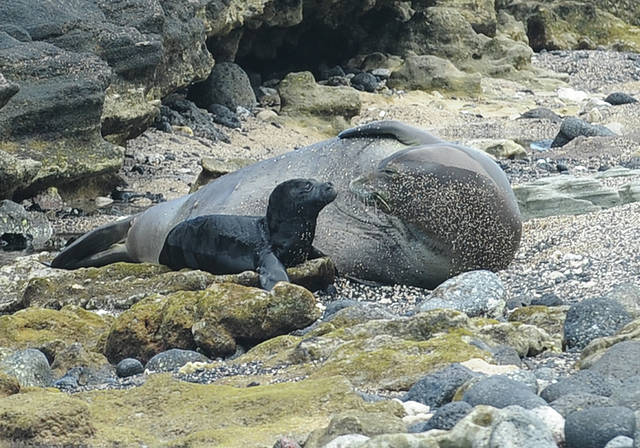
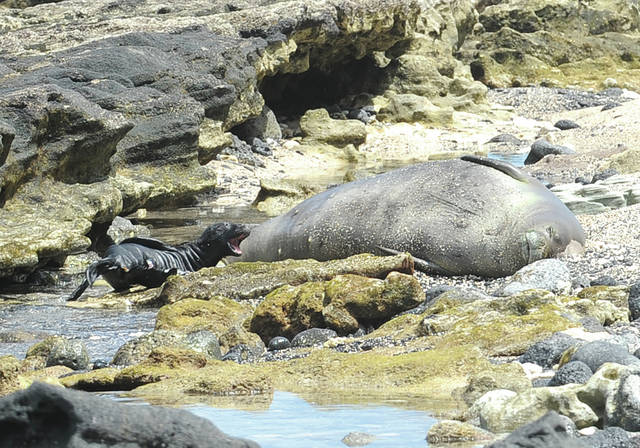
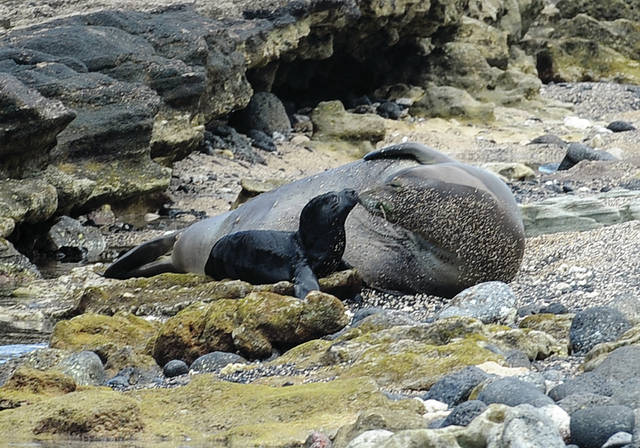
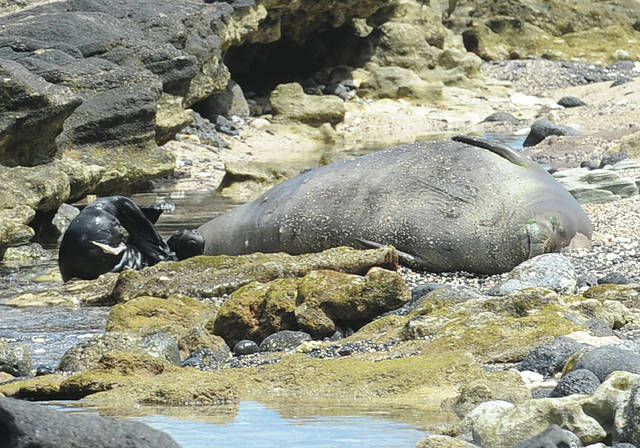
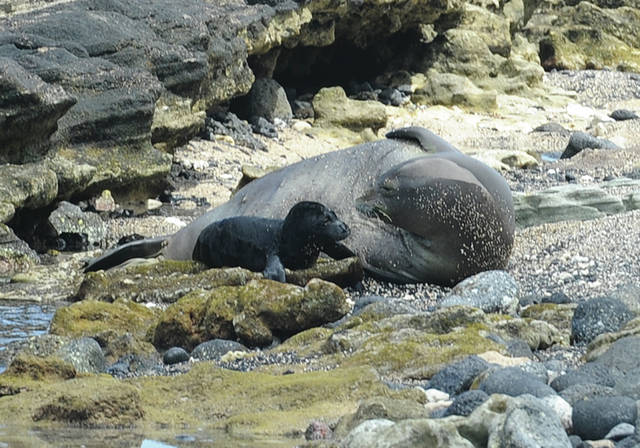
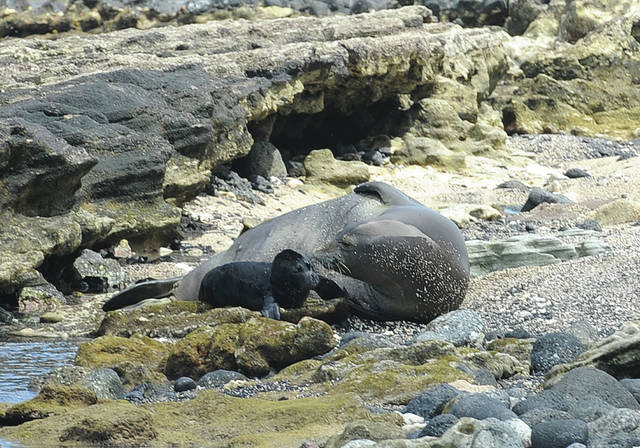
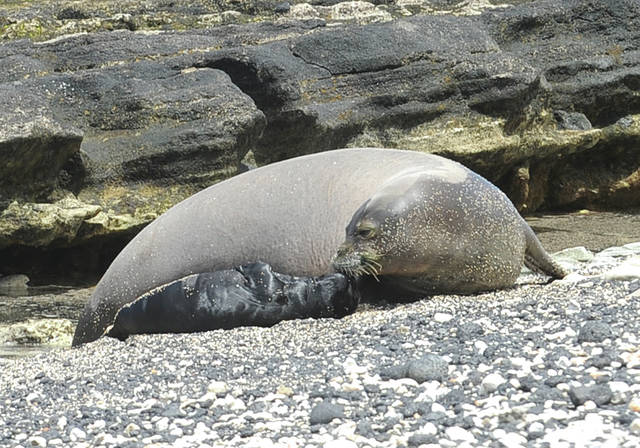
KONA COAST Its said spring breathes new life into the world around us and that was certainly true this year when Hawaiian monk seal RA20 welcomed her second pup Wednesday.
KONA COAST — It’s said spring breathes new life into the world around us — and that was certainly true this year when Hawaiian monk seal RA20 welcomed her second pup Wednesday.
Mom and pup were resting on the sand and rocks on Thursday, marking their second day together at the North Kona locale.
“The pup is looking alert and is actively trying to attempt to nurse,” Claire Simeone, director of The Marine Mammal Center’s Ke Kai Ola Hawaiian Monk Seal Hospital in Kailua-Kona, said as the little seal tried to latch on to its mother for milk as a small crowd of curious onlookers watched.
It’s not yet known whether the seal is male or female. Simeone estimated the pup’s weight at 25-30 pounds, while mom likely tips the scale around 600 pounds.
The youngster is RA20’s second successful pupping at the site. Last year, RA20 birthed a female monk seal that’s been named Manu‘iwa.
Manu‘iwa, who marked her first birthday on Feb. 8, continues to thrive, Simeone said. Though she’s now a year old, Simone said, she’s not expected to begin having her own pups anytime soon.
“We expect it will be a few more years until she is mature,” she said. Female seals usually take about five to six years to reach sexual maturity.
But, Manu‘iwa was apparently curious about her new sibling Thursday morning, coming up on the beach to check out the new addition.
“It was a family reunion,” said Response and Community Engagement Manager Pat Kim.
But it was a quick meeting. The encounter allowed staff to capture photos and video of the trio before RA20 put a kibosh on the “gathering,” positioning herself between the new pup and the older offspring.
“Mom really gave her the talking to,” Simeone said referring to Manu‘iwa. “When moms are pregnant or nursing a pup, they can be really aggressive. They are wild animals and she wants to make sure she is protecting her pup from all potential threats.”
And, that’s why it’s imperative people keep their distance, she added. Ke Kai Ola staff and volunteers have cordoned off the area where mom and pup are, however, a good “rule of thumb” to know if you’re too close to a mother and pup is to hold up your thumb perpendicular to the seal, and if you can see any of the seal you are too close.
“The first three days or so is really critical for that initial bonding, and the entire time mom and pup are together, it’s just so critical for us to give them space and allow them everything they need so that the pup can get what it needs,” Simeone said.
Staff expects RA20 will nurse her pup for about a month or so before weaning commences. Around that time, she’ll leave the pup to fend for itself and survive, like sister, Manu‘iwa did a year ago.
The Marine Mammal Center’s Ke Kai Ola Hawaiian Monk Seal Hospital’s response and community engagement manager Pat Kim and volunteers have been monitoring RA20 for the past couple of months, suspecting that she was pregnant as she cruised the waters off the Big Island.
Sure enough, a pup appeared Wednesday morning, on the first day of spring, she said.
“We’re really excited to see that it was true,” Simeone said.
The report of a little black seal and mother came in Wednesday morning from a visitor at the beach.
“They saw a pup and the placenta, after birth, and they called it in, and we were here within 15 minutes,” Simeone said later noting the monk seal hospital relies on public reports of seal sightings to help staff keep tabs on the endangered marine mammal.
“When there’s a unique event like this, it helps us to respond as quickly as we can,” she said.
Though Ke Kai Ola staff didn’t see the actual birth, they were able to collect the placenta.
“It is really helpful for health assessments and understanding as much as we can about this population,” Simeone said.
The pup is one of an estimated 300 monk seals that call the main Hawaiian Islands home. An additional 1,100 live in the Northwestern Hawaiian Islands, according to the Monk Seal Research Program.
Its birth comes on the heels of a very successful 2018 pupping season. According to the National Oceanic and Atmospheric Administration, 30 pups were born in the main Hawaiian Islands during 2018, beating the previous record of 21 pups in 2013.
Ke Kai Ola is always looking for volunteers to help monitor seals on Hawaii Island. Those interested in volunteering with the nonprofit should call (808) 987-0765. Seal sightings on the Big Island should also be reported to that number.


